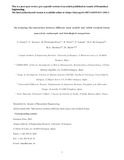Mostrar el registro sencillo del ítem
On studying the interaction between different stent models and rabbit tracheal tissue: numerical, endoscopic and histological comparison
| dc.creator | Chaure, J. | es_ES |
| dc.creator | Serrano, C. | es_ES |
| dc.creator | Fernández-Parra, Rocío | es_ES |
| dc.creator | Peña, Estefanía | es_ES |
| dc.creator | Malvè, Mauro | es_ES |
| dc.date.accessioned | 2020-09-22T07:53:10Z | |
| dc.date.available | 2020-09-22T07:53:10Z | |
| dc.date.issued | 2016 | |
| dc.identifier.issn | 1573-9686 | |
| dc.identifier.uri | https://hdl.handle.net/2454/38156 | |
| dc.description.abstract | Stenting technique is employed worldwide for treating atherosclerotic vessel and tracheal stenosis. Both diseases can be treated by means of metallic stents which present advantages but are affected by the main problem of restenosis of the stented area. In this study we have built a rabbit trachea numerical model and we have analyzed it before and after insertion and opening of two types of commercial stent: a Zilver® FlexTM Stent and a WallStentTM. In experimental parallel work, two types of stent were implanted in 30 New Zealand rabbits divided in two groups of 10 animals corresponding to each stent type and a third group made up of 10 animals without stent. The tracheal wall response was assessed by means of computerized tomography by endoscopy, macroscopic findings and histopathological study 90 days after stent deployment. Three idealized trachea models, one model for each group, were created in order to perform the computational study. The animal model was used to validate the numerical findings and to attempt to find qualitative correlations between numerical and experimental results. Experimental findings such as inflammation, granuloma and abnormal tissue growth, assessed from histomorphometric analyses were compared with derived numerical parameters such as wall shear stress (WSS) and maximum principal stress. The direct comparison of these parameters and the biological response supports the hypothesis that WSS and tensile stresses may lead to a greater tracheal epithelium response within the stented region, with the latter seeming to have the dominant role. This study may be helpful for improving stent design and demonstrates the feasibility offered by in-silico investigated tracheal structural and fluid dynamics. | en |
| dc.description.sponsorship | This study was supported by the CIBER-BBN financed by the Instituto de Salud Carlos III with assistance from the European Regional Development Fund and by the Spanish Ministry of Science and Technology through Research Project DPI2013-44391-P; the Department of Industry and Innovation (Government of Aragón) through the research group Grant T88 (Fondo Social Europeo). The experimental study was supported by the Instituto de Salud Carlos III, through research project PI08/1424 and was performed by the Minimally Invasive Techniques Research Group (GITMI) of Aragón Government. The experimental tests have been performed by the ICTS 'NANBIOSIS', more specifically by the Tissue & Scaffold Characterization Unit (U13) of the CIBER in Bioengineering, Biomaterials & Nanomedicne (CIBER-BBN) at the University of Zaragoza. | en |
| dc.format.extent | 29 p. | |
| dc.format.mimetype | application/pdf | en |
| dc.language.iso | eng | en |
| dc.publisher | Biomedical Engineering Society | en |
| dc.publisher | Springer | en |
| dc.relation.ispartof | Annals of Biomedical Engineering, 2016, 44(2), 368-381 | en |
| dc.rights | © 2015 Biomedical Engineering Society | en |
| dc.subject | Trachea | en |
| dc.subject | Nitinol | en |
| dc.subject | ZilverFlex™ stent | en |
| dc.subject | Wallstent™ | en |
| dc.subject | Fluid-structure interaction | en |
| dc.subject | Finite element method | en |
| dc.title | On studying the interaction between different stent models and rabbit tracheal tissue: numerical, endoscopic and histological comparison | en |
| dc.type | info:eu-repo/semantics/article | en |
| dc.type | Artículo / Artikulua | es |
| dc.contributor.department | Ingeniería Mecánica, Energética y de Materiales | es_ES |
| dc.contributor.department | Mekanika, Energetika eta Materialen Ingeniaritza | eu |
| dc.rights.accessRights | info:eu-repo/semantics/openAccess | en |
| dc.rights.accessRights | Acceso abierto / Sarbide irekia | es |
| dc.identifier.doi | 10.1007/s10439-015-1504-3 | |
| dc.relation.projectID | info:eu-repo/grantAgreement/MINECO//DPI2013-44391-P/ES/ | en |
| dc.relation.publisherversion | https://doi.org/10.1007/s10439-015-1504-3 | |
| dc.type.version | info:eu-repo/semantics/acceptedVersion | en |
| dc.type.version | Versión aceptada / Onetsi den bertsioa | es |


